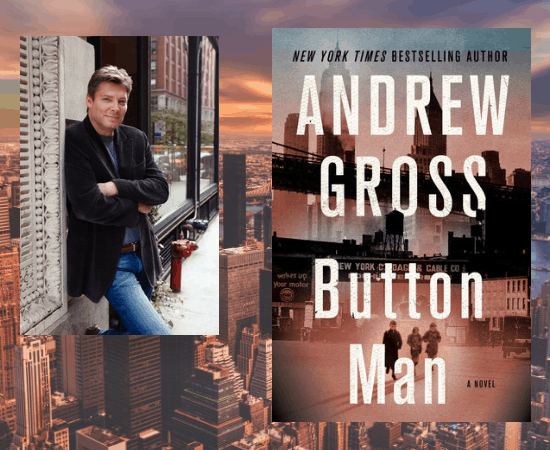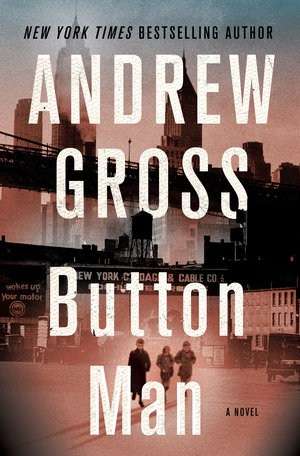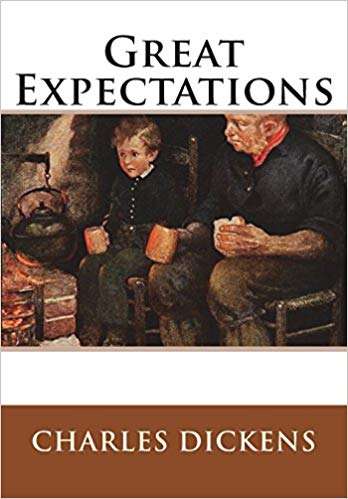Historical thriller author Andrew Gross takes us on a harrowing journey to a part of our past rarely explored in great detail, the Jewish mob’s rise to power in 1930s New York. Although the Italian mob is usually the image we conjure when we think of the racketeering and murder that drenched this time period, the Jewish mob actually played a huge role in taking over the garment industry and enforcing staggering control over the workers, business owners and law enforcement. The courage of the few standing up to unparalleled power and manipulation presented in Button Man (Minotaur) reads as sensational, but the story is actually based on truth from one remarkable man.
As Gross describes in a recent BookTrib interview, “Button Man is about a young hero who grows up on the Lower East Side. He has to go to work and drop out of school at 12 years old to support his family. By the time he is 19, he is running the business he apprenticed with at 12 and has to take on the bloodiest factions of the Jewish mob taking control of the Garment unions. That man was my grandfather.”
Capturing the danger and drama of the 1930s mobsters while weaving a moving family saga following the fated Rabishevskys, Gross has created a thriller both unique and powerful sprung from his grandfather’s own past. In our interview, he unpacks the Jewish mob, some of his grandfather’s most dangerous adventures, and his writing process for Button Man.
![]()
BT: Tell us how Button Man is based on your own family history.
AG: In part, writing Button Man was recording my own family lore. It’s become one of my missions as a writer to leave these behind for my kids so they don’t die with me.
But it wasn’t just about getting down my family history. Most importantly, this story is also pretty unique. I don’t know what readers know about the Jewish mob, most people look kind of glassily when you talk about it. There’s also the formation of the garment industry when for Jews growing up rough and tumble on the Lower East Side, there were two ways out. One of them was clothing where there were no barriers to entry, the poor could get involved with that trade, and the other was crime. I think these aspects lend themselves to a great tale that weaves out over 30 years.
BT: Reading this, I didn’t know much about the whole mob scene, particularly the Jewish mob, and it surprised me.
AG: In the 1930s the Jewish mob was far bloodier than the Italian mob. The Italian mob used to farm their hits out to the Jews who turned it into a business for hire, hence the name Murder Incorporated. I look at my book as Dickens’ Great Expectations meets The Godfather. Great Expectations because it’s the boy-to-manhood story of someone who rises against class struggle, and The Godfather of course because of its depiction of organized crime and its unique cultural aspects — in this case focusing on the Jews instead of the Italians.
The truth is there are names you may or may not know like Arnold Rothstein who fixed the 1919 World Series and gave rise to Shoeless Joe Jackson, thrown out of the league because he was the fixer. There was Dutch Schultz and Bugsy Siegel who started the Las Vegas Strip. Meyer Lanksy was made famous in the movie The Godfather by the character Hyman Roth. So there are all sorts of depictions of the Jewish mob, but still very little is known about it and everyone sort of thinks that they were a bunch of accountants that worked for the bad guys. In fact, many carried out the work of a Button Man, a hit man of the 1930s.
BT: It’s a tall task to stand up to these button men, but Morris does it. How many of these perilous circumstances Morris involves himself with are true anecdotes from your grandfather’s life? I’m thinking especially of the scene where Morris is sitting in the back of a delivery truck with a gun, prepared to face the Jewish mob and protect his inventory with his life. Did that actually happen to your grandfather?
AG: In fact, that was the scene that created the whole book. In my earlier outline, that was the opening chapter. The event that started my path to writing this book was sharing a beer with David Morrell and Dan Palmer at ThrillerFest. I forgot how we got on the subject, but somehow I was telling the story about how my grandfather had to protect his inventory by riding around in the delivery truck with a shotgun, and David just looked at me and said, “That’s great. You gotta write about this.” And it was really the first time I thought that these stories could have a broader appeal than my own family lore. That’s certainly one part of the story that was quite true.
At some point, researching this book took me to the Fashion Institute of Technology (FIT). The head of the archives there, Karen Trivette, showed me microfilms of old editions of Women’s Wear Daily. It was kind of cool, my grandfather as a young man was mentioned quite prominently. She gave me a gift I’ll never forget. She told me many of the founding fathers of this industry have made first-person oral accounts on how they got started, and asked me if I wanted to listen to my grandfather. I could listen to his voice 30 years after he died. With this invaluable resource came many of the italicized sections in the book, straight from his own life.
BT: Your story does not follow the typical murder/mystery structure many thrillers take. It’s more a combination of a family saga and thriller. How did you plan the structure of this story?
AG: I have to admit that right from the start my publisher was concerned this was too much a family saga and not enough of what they were paying me to write, a thriller. It was always my contention to keep the story gripping enough to keep readers going to the second half where it becomes more of a traditional thriller. But you’re right, it is a little different, which is why we went ahead in time in the beginning chapters to show the crime connections, Morris visiting a friend whose business has been trashed and face disfigured by acid.
This tragedy leads him to go to Murder Incorporated, so readers are left at the edge of that conflict before slipping back in time. This part was put in as a concession to let people know that they were getting into a thriller, although I do enjoy the family side of the story as well. It brings up the issue of whether you have to write a thriller with a typical structure to be successful. In my opinion, I don’t think it has to be the traditional structure starting with the crime and solving it.
BT: Family relationships are highly prominent in your tale. From the preface of your story, each brother is described by their mother when they are children, and they never seem to outgrow these first character traits or veer far from her predictions. These roles are empowering for a trailblazing character like Morris and haunting for Harry who feels he can never escape his past. What message about the bound fates or uncanny family dynamics of the Rabishevsky family are you trying to send the readers before even settling into the main story?
AG: Everything starts with that opening chapter, that not only depicts them as children, but describes the family tragedy that determines who these people become in life. Especially Harry, scarred by that family tragedy and feeling responsible for causing it, the event dictates who he is and also sets the course of what happens to the family. Their rise, fall, conflict, betrayal, redemption and forgiveness all stem from this beginning. The feeling of forgiveness is the most powerful, and I hope that emotion is the one the book is left with at the end. Fate is powerful, and Harry’s actions result in a terrible rift and fall for the family, but ultimately he is a redeemable character, not everything is his fault. I’m not sure if it’s something I specifically believe, but in the case of this book, everyone’s fates were decided in that one room on the Lower East Side.
BT: I couldn’t help but sympathize with Harry even though he continued to make poor decisions. He was a likable character despite his flaws.
AG: It’s interesting, even the bad guys, Louis Buchalter for instance, when you take these mobsters, you have to think what’s our fascination with them anyway? They’re these kinds of larger-than-life characters and there’s a likeability as much as a detestability. I never believed in absolute evil in people or villains. I like incremental evil where something happens and every step in life is to make up for it. Even in this book, there’s a lot of respect between the chief adversaries. And it really is just this incrementality, life just takes you one step farther, whether it’s a cover-up or to protect your own interests, all of a sudden you’re standing as a bad guy and someone else is good when in a different point in life you used to just be together.
BT: Great Expectations is referenced many times in the story. Is Charles Dickens one of your favorite writers?
AG: I always identified my grandfather as a Pip-esque character. Even when I would think about him before this book, the novel always stuck in my mind when I thought of my grandfather’s life. Part of it was growing up with nothing, for Pip it was more about becoming a gentleman and then learning of course that it was more of a social commentary. There’s just as much as fraud, deception, phoniness etc. on that side. It was always there, not only the story of Pip but the class struggle Morris goes against. He still rises up from nothing and speaks with marbles in his mouth but at the same time latches onto an educated flapper and pursues her with the same steadfastness he pursues his dreams for his business. I loved writing the chapter when Morris searches for Great Expectations in the bookstore for the first time in his life on Ruthie’s recommendation, and has no idea which section it would be in, history or fiction.
BT: You’ve co-authored multiple books with famed writer James Patterson. What was it like writing with him and what aspects or lessons of the experience did you take with you in establishing yourself as a leading thriller writer?
AG: While I haven’t worked with him for 15 years, there are a couple of things I learned from Jim that I still keep to this day. One of them is that he taught me how to outline in a thorough manner. I still outline my books at least 50 percent ahead of writing them and sometimes even more than that. The One Man, my first historical novel, was sold as an outline, so it reads like an abridged version of the book. I’ve always been a believer of outlining, especially for aspiring writers in the thriller genre because it’s generally so plot-intensive that it’s good to have roadmap before you get started. It allows you to get your arms around the novel as a whole, which can be an unwieldy thing in itself, and at the beginning of your career also prevents you from getting writer’s block since you have a plan for where your book is headed every day.
Another idea that was strong in Jim’s mind was that you should invest your reader in the plight of your hero within the first 10 pages or so.
BT: What are you working on now?
AG: Another historical. It takes place in New York in 1939-1941, before World War II. It mostly takes place in the area of Yorkville, which is on the Upper East Side above 86th street, which was predominantly a German neighborhood. Before the war, Hitler was just a consolidator of power and there were a lot of openly pro-Nazi events. Rallies, patriotic German songs, swastikas hung in restaurants and beer halls. America was divided in its intent to go to the war, and in 1939 22,000 khaki-shirted Americans filled Madison Square Garden to celebrate the Nazi party.
It’s almost inconceivable to think of America this way, but Charles Lindbergh was a Nazi sympathizer along with many others. In this often-overlooked environment, I have a young couple living in a Yorkville brownstone who suspect that the kindly Swiss couple down the hall may be Nazi spies. So it’s early Hitchcock meets Rosemary’s Baby, really diving into Nazi conspiracy.
Button Man is now available for purchase.
Want more BookTrib? Sign up NOW for news and giveaways!
ABOUT ANDREW GROSS:







I loved “Button Man” by Gross, that my two Jewish Book Clubs are each reading and reviewing them. Do you have discussion questions we can use for Monday!s Club? That would be awesome.